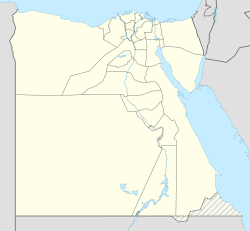Thoth Hill
 View of Thoth Hill | |
| Location | Luxor, North of the Valley of the Kings |
|---|---|
| Region | Upper Egypt |
| Coordinates | 25°45′57″N 32°36′32″E / 25.76583°N 32.60889°E |
| Type | Temple |
| Part of | Luxor |
| History | |
| Founded | Predynastic Egypt |
| Site notes | |
| Public access | No |
Thoth Hill is an archaeological site first dated to predynastic period located on the West Bank of Thebes approximately 3 kilometers north of the Valley of the Kings. A predynastic temple was built over by a mud-brick temple from the 11th Dynasty that is still visible today. The temple was dedicated to the god Horus. The site is the oldest known temple in Thebes.
Background
[edit]The temple was discovered in 1904 by the German Egyptologist Georg Schweinfurth.[1] Further excavations were carried out in 1909 by Flinders Petrie where he found inscribed limestone fragments from a doorframe bearing the names of Mentuhotep III which are now in the Rijksmuseum van Oudheden in Leiden. Petrie was the first to recognize that the stone remains of an earlier temple lie beneath the temple.[2] Schweinfurth and Petrie found fragments of baboon statues of the god Thoth, which led to the mountain's modern name. Thoth may also have been worshipped here.
Between 1995 and 1998, Hungarian excavations under Győző Vörös and Rezső Pudleiner took place. The excavations completely uncovered the later Nile mud-brick temple, examined the stone remains of the older temple beneath the Nile mud floor, and suggested a date before the 11th Dynasty. This stone temple would thus be the oldest known Theban temple. The older stone temple is comparable in plan and size to the later temple. However, the first temple had only one sanctuary. An alabaster vessel, sacrificial bowls, terracotta animal figurines, and the remains of slaughtered animals were found in the foundation pits at the four corners of the temple. The site and its temple were the starting point of a desert road to Middle Egypt. Approximately 130 meters west, another building was discovered that probably served as accommodation for travelers and pilgrims.[3][4][5]
Gallery
[edit]-
Eastern Entrance to the temple
-
Horus temple dated to Mentuhotep III
-
Inside the Horus temple
External links
[edit]References
[edit]- ^ Schweinfurth, Georg (1904). "Ein neuentdeckter Tempel in Theben" (PDF). Zeitschrift für Ägyptische Sprache und Altertumskunde. 41: 22–25. Retrieved 21 April 2025.
- ^ Petrie, W. M. Flinders (1909). "Qurneh" (PDF). Egyptian Research Account and the British School of Archeology in Egypt. 16: 4–6. Retrieved 21 April 2025.
- ^ Vörös, Gyözö; Pudleiner, Rezsö (1997). "The Crown of Thebes". Bulletin of the Egypt Exploration Society. 11: 37–40.
- ^ Vörös, Győző; Pudleiner, Rezső (1997). "Preliminary Report of the Excavations at Thoth Hill, Thebes. The Temple of Montuhotep Sankhkara (Season 1995–1996)". Communications of the German Institute of Egyptian Antiquities in Cairo. 53: 283–287.
- ^ Vörös, Győző; Pudleiner, Rezső. "Preliminary Report of the excavations at Thoth Hill, Thebes. The Pre-11th Dynasty Temple and the Western Building (Season 1996–1997)". Communications of the German Institute of Egyptian Antiquities in Cairo. 54: 335–340.




